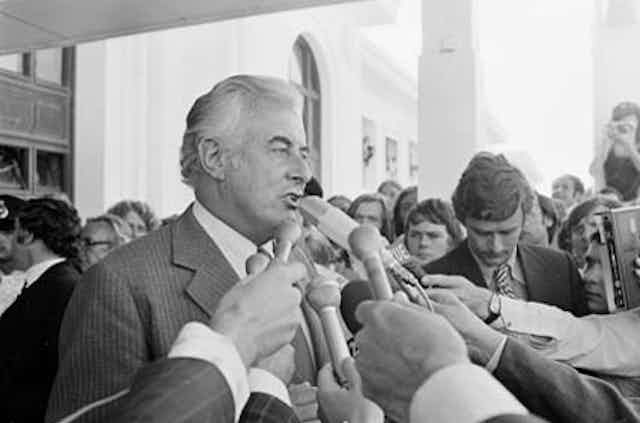The Conversation is running a series of explainers on key moments in Australian political history, looking at what happened, its impact then, and its relevance to politics today.
The dismissal of the Whitlam government provided one of the biggest political shocks in Australian history. It put on open display vice-regal powers that most did not know existed, and tested Australians’ understanding of their own Constitution and political system.
What happened?
On October 16, 1975, the Senate resolved that it would not pass supply until the Whitlam government agreed to call a general election. This meant the Commonwealth would soon run out of money to pay public servants, provide pensions, pay its contractors, and provide services. The Whitlam government decided to tough it out in the hope the Coalition opposition would collapse.
Because the Christmas holidays were approaching, the last day to initiate a pre-Christmas election was November 13, 1975. If that deadline was missed, there would potentially be months of economic chaos with no money to run the government and pay salaries or pensions until February.
On the morning of November 11, Opposition Leader Malcolm Fraser told Gough Whitlam the Opposition would pass supply if Whitlam agreed to hold an election for both houses in May or June 1976. Whitlam refused.
Instead, Whitlam went to the Governor-General, Sir John Kerr, to seek a half-Senate election in December. This would not have been likely to resolve the impasse, and would have been particularly problematic if supply was not granted to cover the election period.
When Whitlam declined to request a general election, Kerr exercised his reserve powers by dismissing Whitlam and his government from office. He then appointed Fraser as prime minister on the condition that he secure the passage of supply, advise the dissolution of both houses of parliament, and call an election in December.
Kerr also stipulated that Fraser’s government must only be a caretaker government that would not make any major appointments or undertake any inquiries or investigations into the Whitlam government. The Senate passed the supply bills and once assent was given to them, both Houses were immediately dissolved.
It was then left to voters in the election to decide who should govern. The former Whitlam government was comprehensively defeated, and the Fraser government was elected to office.
What was its impact?
The reaction was relief for some, and outrage for others. The public and the media, being unfamiliar with constitutional history and the role and powers of vice-regal representatives, saw the Dismissal as unprecedented and shocking.
A martyrdom narrative was constructed – that it was only ever Labor leaders who were dismissed (Whitlam and former NSW premier Jack Lang in 1932), and it was always done by the conservative establishment through undemocratic upper houses. Conspiracy theories flourished, with fingers being pointed at the CIA, the Queen, and the banks, amongst others.
That Kerr had sought advice from the High Court’s chief justice, Sir Garfield Barwick, albeit after Kerr had already made up his mind to dismiss Whitlam, was seen as adding to a conspiracy, because Barwick had previously been a Liberal minister.
Collective amnesia was applied to the fact that such things had happened before. Chief justices had advised governors-general and governors on almost every constitutional controversy since Federation.
Labor had blocked supply in state upper houses before, resulting in the governor, after consulting the chief justice, requiring the resignation of the conservative premier – even when he held a majority in the lower house. It had long been the case that if supply could not be obtained, the only options were resignation, an election, or dismissal (sometimes disguised as a forced resignation).
In 1975, the Speaker asked the Queen to intervene and restore the Whitlam government. In response, the Queen’s private secretary pointed out that the power to appoint and remove the prime minister and dissolve parliament was held by the governor-general, so she could not act.
Many people were influenced by the events of 1975 to support a republic, due to their objection to an unelected representative of the Queen dismissing an elected government that had majority support in the lower house.
Others saw 1975 as revealing the importance of the Senate’s power to block supply, and the need for the reserve powers of the governor-general to resolve a crisis.
All the major participants in the 1975 dismissal were damaged by it. Whitlam was never able to form a government again. Kerr was publicly vilified and led much of his later life outside Australia.
Although he became prime minister, Fraser found his government’s legitimacy undermined by the way it had obtained office, resulting in it being more timid and ineffective than it might otherwise have been.

What are its contemporary implications?
One salutary consequence has been that both governments and oppositions have been more wary about taking matters to extremes, preferring to let conflicts be resolved in the ordinary course by elections.
The Dismissal soured politicians’ taste for brinkmanship. It revealed the likely consequence of a loss of political legitimacy.
Another somewhat ironic consequence is that while the Dismissal fuelled the republican movement, it has also undermined it. The republican model with most public support in Australia is that of a head of state directly elected by the people.
To avert the prospect of a directly elected head of state undermining the indirectly elected prime minister and destabilising the system of government, many consider it would be necessary to remove or codify the powers of the head of state. Yet the ghosts of 1975 have stymied attempts to do so, frustrating any consensus towards a republic.
Harking back to Whitlam’s famous words on the steps of Parliament House, nothing might have saved the governor-general – but the Dismissal appears to have saved the Queen, at least for now.

